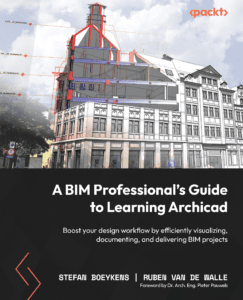Stefan Boeykens is the author of A BIM Professional’s Guide to Learning Archicad; we got the chance to sit down and find out more about his experience of writing with Packt.
Q: What is the name of your book?
Stefan: A BIM Professional’s Guide to Learning Archicad
Q: What are your specialist tech areas?
Stefan: Building Information Modelling
Q: How did you become an author for Packt? Tell us about your journey. What was your motivation for writing this book?
Stefan: This is my second published book with Packt. I was still working at the university when they invited me to write a brief introductory book on using Unity for Architectural Visualization. It was the first of its kind, although the software evolved considerably after that. When I was approached again for this book on Archicad, I knew that such a book could be helpful for my students and other construction professionals. By adding my friend and co-author Ruben Van de Walle, I knew we could reach a higher quality level. Our combined experience as teachers and as users of the software helped us to find a learning path from the very basics up to a level that can be applied professionally.
Q: What kind of research did you do, and how long did you spend researching before beginning the book?
Stefan: To decide on the content of the book, we went through our existing course material and set up a shared online writing space to work on the book outline. That took a few tries to find a logical journey, especially to ensure that concepts are not used before they are introduced. We were given a series of templates and questionnaires to bring everything into a fully planned stage, before the actual writing could start, a few weeks later (or was it months?)
Q: Did you face any challenges during the writing process? How did you overcome them?
Stefan: While writing takes a lot of effort, the first chapters went fast. But we found out, gradually, that the software that we love and use for so many years, is very extensive… When you must explain it to a first-time user, there aren’t many steps you can skip. And the length of chapters started to increase and increase and eventually, we had to split chapters to a more manageable length. But the hardest decision was the stuff we had to leave out. Some of the concepts we use in our BIM practice had to be removed, such as dealing with GDL, Teamwork, and IFC. Rather than forcing these subjects into small sections, we hope to, one day, elaborate them in full, to complete the Archicad journey.
Q: What’s your take on the technologies discussed in the book? Where do you see these technologies heading in the future?
Stefan: BIM is here to stay. And we believe that Archicad, even after 40+ years of development from its humble beginnings in Hungary in the ‘80s, it is still an innovative and relevant BIM authoring software, despite fierce competition from Revit. It is amazing to see how Graphisoft was able to keep the software going all those years, through the evolution of the different platforms and generations of Windows and macOS, adopting many new technologies along the way: real-time textured 3D views with shadows using Open GL and Metal, multi-threading processing, evolving from PowerPC to Intel and recently ARM CPUs, from 32-bit to 64-bit across multiple language versions. And the recently released public roadmap shows that Graphisoft remains ambitious with its flagship software.
Q: Why should readers choose this book over others already on the market? How would you differentiate your book from its competition?
Stefan: While the number of books on Archicad slowly increases, there aren’t that many books on Archicad which are still up to date. We believe that our book has a logical pathway through the software and that it teaches usable and efficient methods for modeling and drafting. We take the reader by the hand, initially, with many step-by-step sections, but gradually move to an intermediate level, where we focus more on understanding the why and how, rather than sticking to cookbook recipes. We hope the reader gets a more thorough insight into the Archicad way of working.
Q: What are the key takeaways you want readers to come away with from the book?
Stefan: This book cannot possibly cover everything there is to learn about Archicad, but it brings the reader to a level where they will feel comfortable using the software and figuring out things on their own. Archicad is a complex and deep software, but we hope that our book can keep everything logical and comprehensive, so it makes sense. But as always, for every feature we explain, there are countless options and variants we could not cover. So we also assume that some self-learning is needed.
Q. What advice would you give to readers jumping into this technology? Do you have any top tips?
Stefan: While the software is mature and user-friendly, it is deep, as a professional tool. We strongly recommend using proper training, either in-person or self-paced. And that is where our book fits in. Secondly, take it not too fast. While it can be enticing to create highly complex models, your first model is probably more modest. We deliberately tried to guide the reader through a small-scale project but focus on methodology and best practices.
Q. Do you have a blog that readers can follow?
Stefan: I used to have a very active blog for a while, at https://cad-3d.blogspot.com but that has dried up. But I do post articles on LinkedIn (https://www.linkedin.com/in/stefanboeykens) occasionally, either as my own ideas or in reacting to others. And I feel that has a nice impact and I often get reactions, which is lovely. I also have a YouTube channel, but that, also, slowed down a lot. I like to share knowledge and help bring other people to a higher level.
Q: Can you share any blogs, websites, and forums to help readers gain a holistic view of the tech they are learning? What are the key takeaways you want readers to come away with from the book?
Stefan: For Archicad, we provided quite some links in the book. There are the blogs of a few experts, such as Eric Bobrow, Jared Banks (shoegnome), or Nathan Hildebrandt (skewed), which give plenty of insight and professional guidance. And the Archicad community website (https://community.graphisoft.com) is very, very extensive, with a forum covering posts from a long time ago (always be mindful of a post date before you follow recommended techniques). It’s much more dynamic and extensive than it used to be when the “archicad-talk” was mostly a mailing list. And finally, don’t forget to talk to your local resellers, as they may help you with regional tips and best practices and they may have Archicad-related events from time to time.
Q. How would you describe your author’s journey with Packt? Would you recommend Packt to aspiring authors?
Stefan: It’s my second experience, after the Unity book and video. They do things a bit in a different way than traditional publishers: you don’t necessarily need to be an established writer if you are an expert in the field. They have a full process and support team to bring you through outline writing, planning, writing (you still must do this bit yourself), and the reviewing and publishing process. And don’t forget marketing in the end. If you feel you can take on everything else as well, together with the writing, you could try self-publishing, but I know that this may have resulted in the book not being published still. Having teaching experience was how Ruben and myself were able to bring our knowledge into a learning path. And experience takes time and passion.
Q. Do you belong to any tech community groups?
Stefan: Less than I used to… I follow LinkedIn and my network is the main source of staying up to date. I visit the Archicad community often, but not daily. And I return to the buildingSMART forums frequently, to stay aware of the evolution of open BIM standards.
Q. What are your favorite tech journals? How do you keep yourself up to date on tech?
Stefan: To be honest, I used to keep up to date reading books at the beginning of my career, on AutoCAD, 3D Studio, Microsoft Excel, VBA, PHP, Drupal, Unity, Rhinoceros, C++, Python, etc… Then there was an era where I mostly followed video courses, starting with 3DBuzz, while also being subscribed to 3D World magazine. This was mostly oriented to 3D FX and animation. Recently, it’s mostly LinkedIn and Twitter to follow up activities. And that often leads to articles, blogs, YouTube videos, or, occasionally, books. One of the last BIM-related books I read was “Understanding BIM, the Past, Present and Future”, by Jonathan Ingram, where he explained the predecessors of Revit, mainly.
Q. How did you organize, plan, and prioritize your work and write the book?
Stefan: It was evening and weekend work, to be honest. And it took some effort to stick to the publication plan, which became harder as we continued writing because it became clear very quickly that the original scope of 300 to 400 pages would not be enough… I have plenty to tell for another book, still, but that will have to wait a bit.
Q. What is that one writing tip that you found most crucial and would like to share with aspiring authors?
Stefan: Don’t give up. Set small accomplishment targets and celebrate them. For example: “I have now written a third chapter of my book! yeah!!” When I got to over 50% of the book I knew I had to press on. Also, go for walks when you get stuck, it will help clear the mind. You subconsciously will be writing the book as you do other activities so that when you go back to that blank computer screen the words will come.
Q. Would you like to share your social handles? If so, please share.
Stefan: Facebook | LinkedIn | Twitter
You can find Stefan’s book on Amazon by following this link: Please click here









